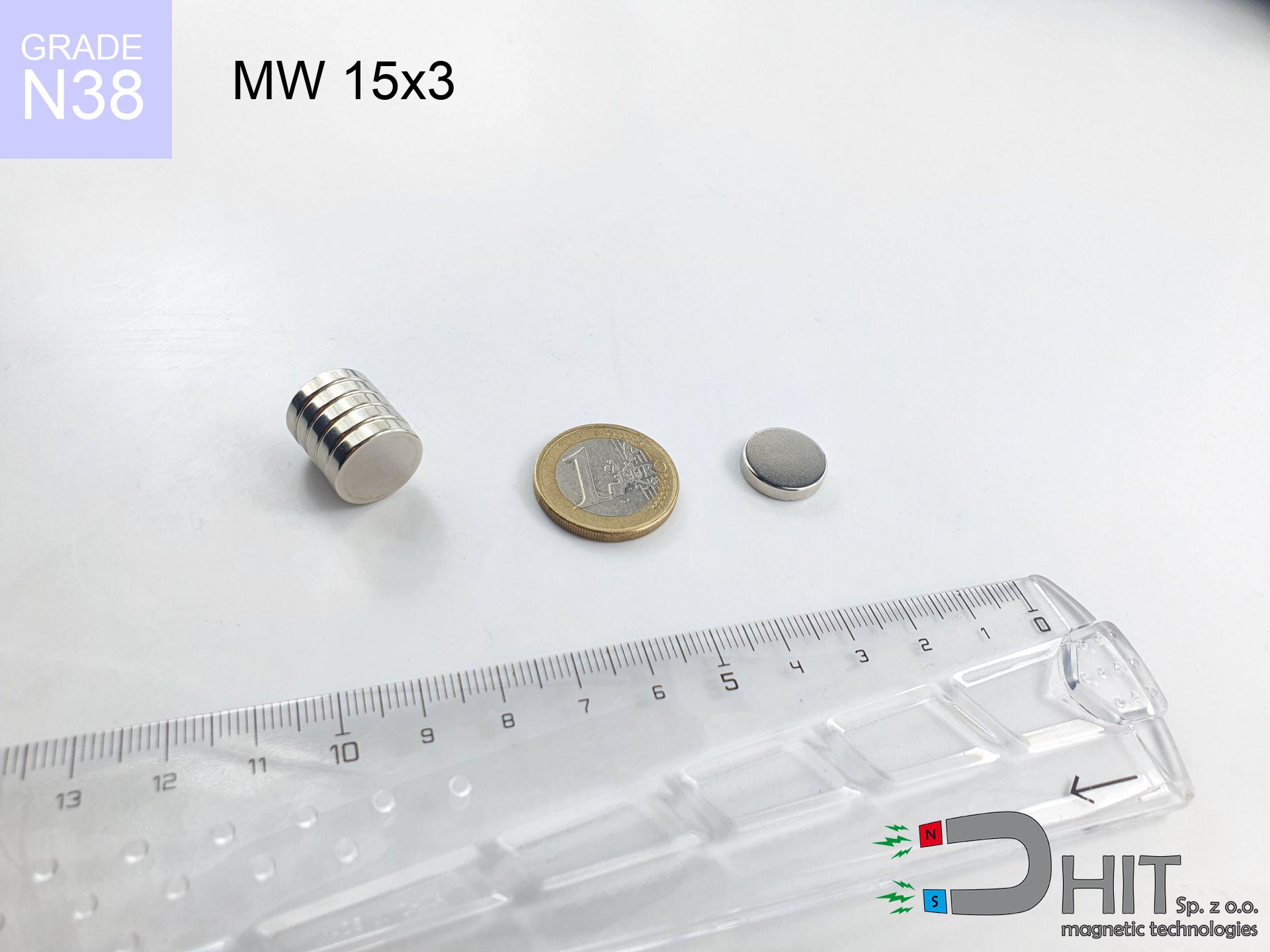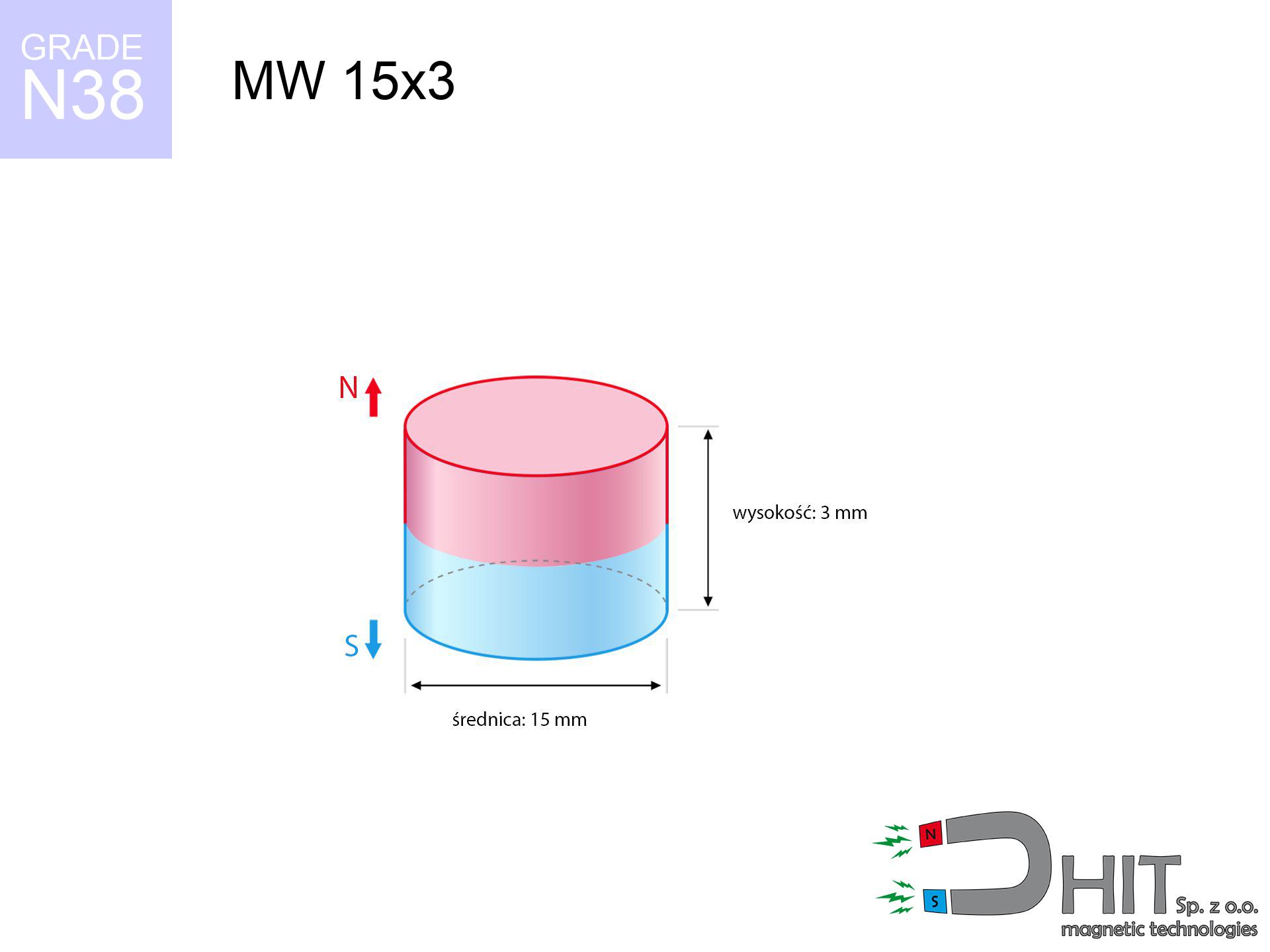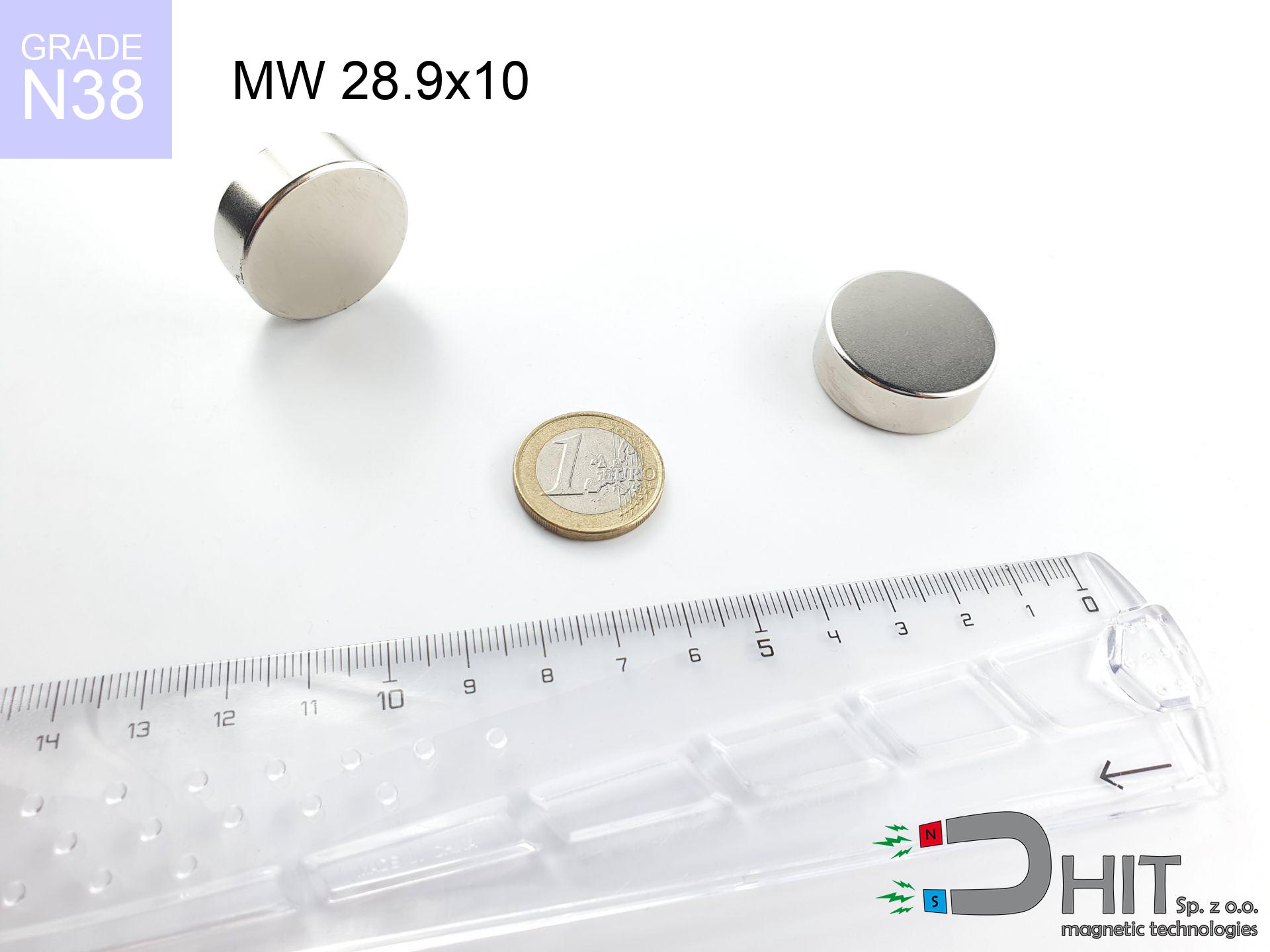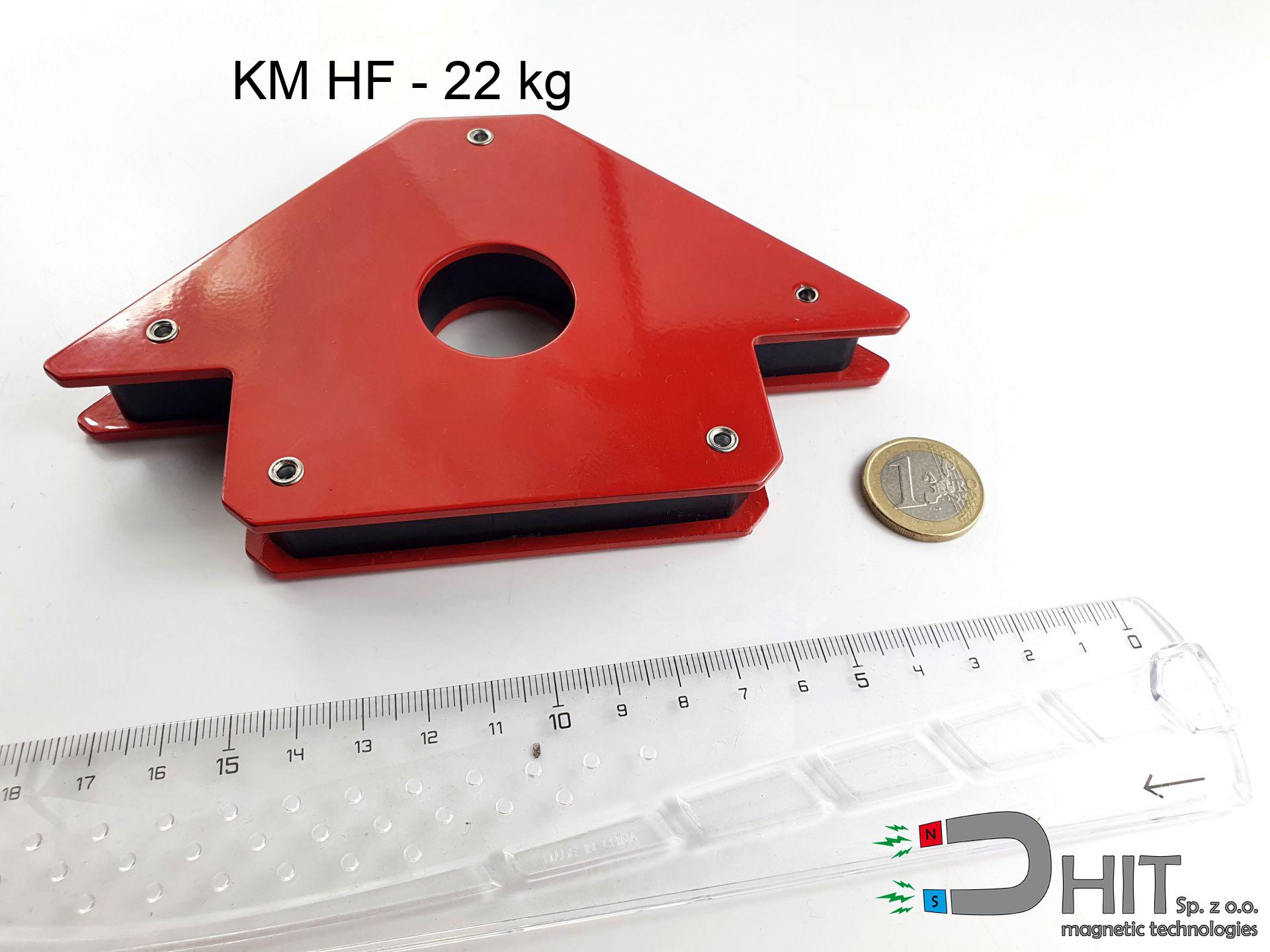MW 15x3 / N38 - cylindrical magnet
cylindrical magnet
Catalog no 010029
GTIN/EAN: 5906301810285
Diameter Ø
15 mm [±0,1 mm]
Height
3 mm [±0,1 mm]
Weight
3.98 g
Magnetization Direction
↑ axial
Load capacity
2.87 kg / 28.14 N
Magnetic Induction
230.16 mT / 2302 Gs
Coating
[NiCuNi] Nickel
1.624 ZŁ with VAT / pcs + price for transport
1.320 ZŁ net + 23% VAT / pcs
bulk discounts:
Need more?
Contact us by phone
+48 22 499 98 98
or drop us a message using
contact form
our website.
Parameters as well as structure of a magnet can be analyzed with our
force calculator.
Same-day shipping for orders placed before 14:00.
Physical properties - MW 15x3 / N38 - cylindrical magnet
Specification / characteristics - MW 15x3 / N38 - cylindrical magnet
| properties | values |
|---|---|
| Cat. no. | 010029 |
| GTIN/EAN | 5906301810285 |
| Production/Distribution | Dhit sp. z o.o. |
| Country of origin | Poland / China / Germany |
| Customs code | 85059029 |
| Diameter Ø | 15 mm [±0,1 mm] |
| Height | 3 mm [±0,1 mm] |
| Weight | 3.98 g |
| Magnetization Direction | ↑ axial |
| Load capacity ~ ? | 2.87 kg / 28.14 N |
| Magnetic Induction ~ ? | 230.16 mT / 2302 Gs |
| Coating | [NiCuNi] Nickel |
| Manufacturing Tolerance | ±0.1 mm |
Magnetic properties of material N38
| properties | values | units |
|---|---|---|
| remenance Br [min. - max.] ? | 12.2-12.6 | kGs |
| remenance Br [min. - max.] ? | 1220-1260 | mT |
| coercivity bHc ? | 10.8-11.5 | kOe |
| coercivity bHc ? | 860-915 | kA/m |
| actual internal force iHc | ≥ 12 | kOe |
| actual internal force iHc | ≥ 955 | kA/m |
| energy density [min. - max.] ? | 36-38 | BH max MGOe |
| energy density [min. - max.] ? | 287-303 | BH max KJ/m |
| max. temperature ? | ≤ 80 | °C |
Physical properties of sintered neodymium magnets Nd2Fe14B at 20°C
| properties | values | units |
|---|---|---|
| Vickers hardness | ≥550 | Hv |
| Density | ≥7.4 | g/cm3 |
| Curie Temperature TC | 312 - 380 | °C |
| Curie Temperature TF | 593 - 716 | °F |
| Specific resistance | 150 | μΩ⋅cm |
| Bending strength | 250 | MPa |
| Compressive strength | 1000~1100 | MPa |
| Thermal expansion parallel (∥) to orientation (M) | (3-4) x 10-6 | °C-1 |
| Thermal expansion perpendicular (⊥) to orientation (M) | -(1-3) x 10-6 | °C-1 |
| Young's modulus | 1.7 x 104 | kg/mm² |
Physical simulation of the magnet - data
Presented information are the result of a mathematical analysis. Results rely on models for the class Nd2Fe14B. Actual performance might slightly differ from theoretical values. Use these calculations as a preliminary roadmap during assembly planning.
Table 1: Static force (force vs distance) - characteristics
MW 15x3 / N38
| Distance (mm) | Induction (Gauss) / mT | Pull Force (kg/lbs/g/N) | Risk Status |
|---|---|---|---|
| 0 mm |
2301 Gs
230.1 mT
|
2.87 kg / 6.33 pounds
2870.0 g / 28.2 N
|
warning |
| 1 mm |
2098 Gs
209.8 mT
|
2.39 kg / 5.26 pounds
2386.5 g / 23.4 N
|
warning |
| 2 mm |
1842 Gs
184.2 mT
|
1.84 kg / 4.05 pounds
1838.5 g / 18.0 N
|
low risk |
| 3 mm |
1570 Gs
157.0 mT
|
1.34 kg / 2.95 pounds
1337.0 g / 13.1 N
|
low risk |
| 5 mm |
1084 Gs
108.4 mT
|
0.64 kg / 1.40 pounds
637.0 g / 6.2 N
|
low risk |
| 10 mm |
410 Gs
41.0 mT
|
0.09 kg / 0.20 pounds
91.3 g / 0.9 N
|
low risk |
| 15 mm |
178 Gs
17.8 mT
|
0.02 kg / 0.04 pounds
17.1 g / 0.2 N
|
low risk |
| 20 mm |
89 Gs
8.9 mT
|
0.00 kg / 0.01 pounds
4.3 g / 0.0 N
|
low risk |
| 30 mm |
31 Gs
3.1 mT
|
0.00 kg / 0.00 pounds
0.5 g / 0.0 N
|
low risk |
| 50 mm |
7 Gs
0.7 mT
|
0.00 kg / 0.00 pounds
0.0 g / 0.0 N
|
low risk |
Table 2: Shear load (wall)
MW 15x3 / N38
| Distance (mm) | Friction coefficient | Pull Force (kg/lbs/g/N) |
|---|---|---|
| 0 mm | Stal (~0.2) |
0.57 kg / 1.27 pounds
574.0 g / 5.6 N
|
| 1 mm | Stal (~0.2) |
0.48 kg / 1.05 pounds
478.0 g / 4.7 N
|
| 2 mm | Stal (~0.2) |
0.37 kg / 0.81 pounds
368.0 g / 3.6 N
|
| 3 mm | Stal (~0.2) |
0.27 kg / 0.59 pounds
268.0 g / 2.6 N
|
| 5 mm | Stal (~0.2) |
0.13 kg / 0.28 pounds
128.0 g / 1.3 N
|
| 10 mm | Stal (~0.2) |
0.02 kg / 0.04 pounds
18.0 g / 0.2 N
|
| 15 mm | Stal (~0.2) |
0.00 kg / 0.01 pounds
4.0 g / 0.0 N
|
| 20 mm | Stal (~0.2) |
0.00 kg / 0.00 pounds
0.0 g / 0.0 N
|
| 30 mm | Stal (~0.2) |
0.00 kg / 0.00 pounds
0.0 g / 0.0 N
|
| 50 mm | Stal (~0.2) |
0.00 kg / 0.00 pounds
0.0 g / 0.0 N
|
Table 3: Vertical assembly (sliding) - vertical pull
MW 15x3 / N38
| Surface type | Friction coefficient / % Mocy | Max load (kg/lbs/g/N) |
|---|---|---|
| Raw steel |
µ = 0.3
30% Nominalnej Siły
|
0.86 kg / 1.90 pounds
861.0 g / 8.4 N
|
| Painted steel (standard) |
µ = 0.2
20% Nominalnej Siły
|
0.57 kg / 1.27 pounds
574.0 g / 5.6 N
|
| Oily/slippery steel |
µ = 0.1
10% Nominalnej Siły
|
0.29 kg / 0.63 pounds
287.0 g / 2.8 N
|
| Magnet with anti-slip rubber |
µ = 0.5
50% Nominalnej Siły
|
1.44 kg / 3.16 pounds
1435.0 g / 14.1 N
|
Table 4: Material efficiency (saturation) - power losses
MW 15x3 / N38
| Steel thickness (mm) | % power | Real pull force (kg/lbs/g/N) |
|---|---|---|
| 0.5 mm |
|
0.29 kg / 0.63 pounds
287.0 g / 2.8 N
|
| 1 mm |
|
0.72 kg / 1.58 pounds
717.5 g / 7.0 N
|
| 2 mm |
|
1.44 kg / 3.16 pounds
1435.0 g / 14.1 N
|
| 3 mm |
|
2.15 kg / 4.75 pounds
2152.5 g / 21.1 N
|
| 5 mm |
|
2.87 kg / 6.33 pounds
2870.0 g / 28.2 N
|
| 10 mm |
|
2.87 kg / 6.33 pounds
2870.0 g / 28.2 N
|
| 11 mm |
|
2.87 kg / 6.33 pounds
2870.0 g / 28.2 N
|
| 12 mm |
|
2.87 kg / 6.33 pounds
2870.0 g / 28.2 N
|
Table 5: Working in heat (material behavior) - power drop
MW 15x3 / N38
| Ambient temp. (°C) | Power loss | Remaining pull (kg/lbs/g/N) | Status |
|---|---|---|---|
| 20 °C | 0.0% |
2.87 kg / 6.33 pounds
2870.0 g / 28.2 N
|
OK |
| 40 °C | -2.2% |
2.81 kg / 6.19 pounds
2806.9 g / 27.5 N
|
OK |
| 60 °C | -4.4% |
2.74 kg / 6.05 pounds
2743.7 g / 26.9 N
|
|
| 80 °C | -6.6% |
2.68 kg / 5.91 pounds
2680.6 g / 26.3 N
|
|
| 100 °C | -28.8% |
2.04 kg / 4.51 pounds
2043.4 g / 20.0 N
|
Table 6: Two magnets (attraction) - forces in the system
MW 15x3 / N38
| Gap (mm) | Attraction (kg/lbs) (N-S) | Shear Strength (kg/lbs/g/N) | Repulsion (kg/lbs) (N-N) |
|---|---|---|---|
| 0 mm |
5.77 kg / 12.72 pounds
3 869 Gs
|
0.87 kg / 1.91 pounds
865 g / 8.5 N
|
N/A |
| 1 mm |
5.32 kg / 11.73 pounds
4 419 Gs
|
0.80 kg / 1.76 pounds
798 g / 7.8 N
|
4.79 kg / 10.55 pounds
~0 Gs
|
| 2 mm |
4.80 kg / 10.57 pounds
4 196 Gs
|
0.72 kg / 1.59 pounds
719 g / 7.1 N
|
4.32 kg / 9.52 pounds
~0 Gs
|
| 3 mm |
4.25 kg / 9.36 pounds
3 948 Gs
|
0.64 kg / 1.40 pounds
637 g / 6.2 N
|
3.82 kg / 8.42 pounds
~0 Gs
|
| 5 mm |
3.17 kg / 6.99 pounds
3 412 Gs
|
0.48 kg / 1.05 pounds
476 g / 4.7 N
|
2.85 kg / 6.29 pounds
~0 Gs
|
| 10 mm |
1.28 kg / 2.82 pounds
2 168 Gs
|
0.19 kg / 0.42 pounds
192 g / 1.9 N
|
1.15 kg / 2.54 pounds
~0 Gs
|
| 20 mm |
0.18 kg / 0.40 pounds
821 Gs
|
0.03 kg / 0.06 pounds
28 g / 0.3 N
|
0.17 kg / 0.36 pounds
~0 Gs
|
| 50 mm |
0.00 kg / 0.01 pounds
101 Gs
|
0.00 kg / 0.00 pounds
0 g / 0.0 N
|
0.00 kg / 0.00 pounds
~0 Gs
|
| 60 mm |
0.00 kg / 0.00 pounds
62 Gs
|
0.00 kg / 0.00 pounds
0 g / 0.0 N
|
0.00 kg / 0.00 pounds
~0 Gs
|
| 70 mm |
0.00 kg / 0.00 pounds
41 Gs
|
0.00 kg / 0.00 pounds
0 g / 0.0 N
|
0.00 kg / 0.00 pounds
~0 Gs
|
| 80 mm |
0.00 kg / 0.00 pounds
28 Gs
|
0.00 kg / 0.00 pounds
0 g / 0.0 N
|
0.00 kg / 0.00 pounds
~0 Gs
|
| 90 mm |
0.00 kg / 0.00 pounds
20 Gs
|
0.00 kg / 0.00 pounds
0 g / 0.0 N
|
0.00 kg / 0.00 pounds
~0 Gs
|
| 100 mm |
0.00 kg / 0.00 pounds
15 Gs
|
0.00 kg / 0.00 pounds
0 g / 0.0 N
|
0.00 kg / 0.00 pounds
~0 Gs
|
Table 7: Safety (HSE) (implants) - warnings
MW 15x3 / N38
| Object / Device | Limit (Gauss) / mT | Safe distance |
|---|---|---|
| Pacemaker | 5 Gs (0.5 mT) | 6.0 cm |
| Hearing aid | 10 Gs (1.0 mT) | 5.0 cm |
| Mechanical watch | 20 Gs (2.0 mT) | 4.0 cm |
| Phone / Smartphone | 40 Gs (4.0 mT) | 3.0 cm |
| Remote | 50 Gs (5.0 mT) | 3.0 cm |
| Payment card | 400 Gs (40.0 mT) | 1.5 cm |
| HDD hard drive | 600 Gs (60.0 mT) | 1.0 cm |
Table 8: Impact energy (kinetic energy) - warning
MW 15x3 / N38
| Start from (mm) | Speed (km/h) | Energy (J) | Predicted outcome |
|---|---|---|---|
| 10 mm |
27.62 km/h
(7.67 m/s)
|
0.12 J | |
| 30 mm |
46.91 km/h
(13.03 m/s)
|
0.34 J | |
| 50 mm |
60.56 km/h
(16.82 m/s)
|
0.56 J | |
| 100 mm |
85.64 km/h
(23.79 m/s)
|
1.13 J |
Table 9: Anti-corrosion coating durability
MW 15x3 / N38
| Technical parameter | Value / Description |
|---|---|
| Coating type | [NiCuNi] Nickel |
| Layer structure | Nickel - Copper - Nickel |
| Layer thickness | 10-20 µm |
| Salt spray test (SST) ? | 24 h |
| Recommended environment | Indoors only (dry) |
Table 10: Electrical data (Pc)
MW 15x3 / N38
| Parameter | Value | SI Unit / Description |
|---|---|---|
| Magnetic Flux | 4 718 Mx | 47.2 µWb |
| Pc Coefficient | 0.29 | Low (Flat) |
Table 11: Submerged application
MW 15x3 / N38
| Environment | Effective steel pull | Effect |
|---|---|---|
| Air (land) | 2.87 kg | Standard |
| Water (riverbed) |
3.29 kg
(+0.42 kg buoyancy gain)
|
+14.5% |
1. Shear force
*Note: On a vertical surface, the magnet holds just approx. 20-30% of its nominal pull.
2. Plate thickness effect
*Thin steel (e.g. 0.5mm PC case) severely weakens the holding force.
3. Heat tolerance
*For N38 material, the safety limit is 80°C.
4. Demagnetization curve and operating point (B-H)
chart generated for the permeance coefficient Pc (Permeance Coefficient) = 0.29
The chart above illustrates the magnetic characteristics of the material within the second quadrant of the hysteresis loop. The solid red line represents the demagnetization curve (material potential), while the dashed blue line is the load line based on the magnet's geometry. The Pc (Permeance Coefficient), also known as the load line slope, is a dimensionless value that describes the relationship between the magnet's shape and its magnetic stability. The intersection of these two lines (the black dot) is the operating point — it determines the actual magnetic flux density generated by the magnet in this specific configuration. A higher Pc value means the magnet is more 'slender' (tall relative to its area), resulting in a higher operating point and better resistance to irreversible demagnetization caused by external fields or temperature. A value of 0.42 is relatively low (typical for flat magnets), meaning the operating point is closer to the 'knee' of the curve — caution is advised when operating at temperatures near the maximum limit to avoid strength loss.
Elemental analysis
| iron (Fe) | 64% – 68% |
| neodymium (Nd) | 29% – 32% |
| boron (B) | 1.1% – 1.2% |
| dysprosium (Dy) | 0.5% – 2.0% |
| coating (Ni-Cu-Ni) | < 0.05% |
Ecology and recycling (GPSR)
| recyclability (EoL) | 100% |
| recycled raw materials | ~10% (pre-cons) |
| carbon footprint | low / zredukowany |
| waste code (EWC) | 16 02 16 |
Check out also offers
Strengths as well as weaknesses of rare earth magnets.
Pros
- They virtually do not lose strength, because even after 10 years the performance loss is only ~1% (according to literature),
- They do not lose their magnetic properties even under close interference source,
- The use of an metallic coating of noble metals (nickel, gold, silver) causes the element to present itself better,
- Neodymium magnets achieve maximum magnetic induction on a small surface, which ensures high operational effectiveness,
- Due to their durability and thermal resistance, neodymium magnets can operate (depending on the form) even at high temperatures reaching 230°C or more...
- Thanks to freedom in shaping and the ability to modify to unusual requirements,
- Wide application in future technologies – they are commonly used in mass storage devices, motor assemblies, medical devices, and multitasking production systems.
- Compactness – despite small sizes they provide effective action, making them ideal for precision applications
Disadvantages
- They are fragile upon too strong impacts. To avoid cracks, it is worth securing magnets in special housings. Such protection not only protects the magnet but also improves its resistance to damage
- NdFeB magnets lose power when exposed to high temperatures. After reaching 80°C, many of them experience permanent drop of power (a factor is the shape as well as dimensions of the magnet). We offer magnets specially adapted to work at temperatures up to 230°C marked [AH], which are extremely resistant to heat
- They oxidize in a humid environment - during use outdoors we recommend using waterproof magnets e.g. in rubber, plastic
- We recommend casing - magnetic mechanism, due to difficulties in producing nuts inside the magnet and complex forms.
- Potential hazard related to microscopic parts of magnets are risky, if swallowed, which is particularly important in the context of child health protection. It is also worth noting that tiny parts of these products can be problematic in diagnostics medical in case of swallowing.
- High unit price – neodymium magnets are more expensive than other types of magnets (e.g. ferrite), which hinders application in large quantities
Pull force analysis
Magnetic strength at its maximum – what contributes to it?
- on a plate made of mild steel, effectively closing the magnetic flux
- possessing a thickness of at least 10 mm to avoid saturation
- with an ideally smooth touching surface
- under conditions of ideal adhesion (metal-to-metal)
- during detachment in a direction vertical to the plane
- at ambient temperature room level
Practical aspects of lifting capacity – factors
- Distance (betwixt the magnet and the plate), as even a very small clearance (e.g. 0.5 mm) can cause a reduction in lifting capacity by up to 50% (this also applies to paint, corrosion or dirt).
- Force direction – declared lifting capacity refers to detachment vertically. When slipping, the magnet holds significantly lower power (typically approx. 20-30% of maximum force).
- Metal thickness – the thinner the sheet, the weaker the hold. Magnetic flux penetrates through instead of generating force.
- Plate material – mild steel gives the best results. Higher carbon content reduce magnetic properties and holding force.
- Surface condition – ground elements guarantee perfect abutment, which increases field saturation. Uneven metal weaken the grip.
- Temperature influence – hot environment weakens magnetic field. Exceeding the limit temperature can permanently damage the magnet.
Lifting capacity was determined with the use of a steel plate with a smooth surface of optimal thickness (min. 20 mm), under perpendicular detachment force, however under parallel forces the load capacity is reduced by as much as fivefold. In addition, even a small distance between the magnet and the plate decreases the load capacity.
Warnings
Medical implants
Warning for patients: Powerful magnets disrupt medical devices. Keep at least 30 cm distance or ask another person to handle the magnets.
Permanent damage
Do not overheat. Neodymium magnets are susceptible to temperature. If you need resistance above 80°C, ask us about special high-temperature series (H, SH, UH).
Allergic reactions
Certain individuals experience a sensitization to nickel, which is the typical protective layer for neodymium magnets. Frequent touching may cause a rash. We strongly advise wear safety gloves.
Physical harm
Protect your hands. Two powerful magnets will snap together immediately with a force of several hundred kilograms, crushing anything in their path. Exercise extreme caution!
Machining danger
Combustion risk: Rare earth powder is explosive. Avoid machining magnets without safety gear as this may cause fire.
Protective goggles
Despite metallic appearance, neodymium is delicate and cannot withstand shocks. Do not hit, as the magnet may shatter into sharp, dangerous pieces.
Do not give to children
Neodymium magnets are not suitable for play. Accidental ingestion of several magnets may result in them pinching intestinal walls, which constitutes a severe health hazard and necessitates urgent medical intervention.
Keep away from computers
Intense magnetic fields can corrupt files on credit cards, hard drives, and other magnetic media. Keep a distance of min. 10 cm.
GPS Danger
An intense magnetic field interferes with the operation of compasses in phones and navigation systems. Keep magnets near a device to avoid damaging the sensors.
Powerful field
Exercise caution. Rare earth magnets attract from a long distance and connect with huge force, often faster than you can react.




![UMGGZ 22x6 [M4] GZ / N38 - rubber magnetic holder external thread UMGGZ 22x6 [M4] GZ / N38 - rubber magnetic holder external thread](https://cdn3.dhit.pl/graphics/products/umg-22x6-m4-gz-hiw.jpg)
![SM 32x200 [2xM8] / N42 - magnetic separator SM 32x200 [2xM8] / N42 - magnetic separator](https://cdn3.dhit.pl/graphics/products/sm-32x200-2xm8-fub.jpg)



